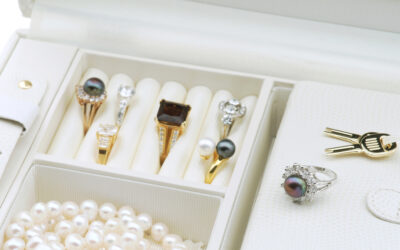Decluttering is all the rage right now, especially with Marie Kondo and her method taking the pop culture world by storm. It seems like everywhere you turn, someone is talking about Kondo-ing their space, decluttering their life, or moving towards minimalism.
For those who haven’t embarked on the decluttering journey before, cleaning out your home or apartment can seem huge. But you don’t have to hire a professional organizer to turn your home into a clutter-free haven.
One of the most important things we’ve learned over the years is this: The key to decluttering isn’t trying to do it all once. Instead it’s important to take baby steps so you don’t get too overwhelmed and give up. Developing daily routines to put things in their proper place is key to maintaining a clutter-free home.
Ready to get started? Here are 25 decluttering tips we’ve collected from professionals and years of our own blog posts for decluttering your home, and keeping it that way.
1. Take Baby Steps.
As we mentioned above, one of the most important things to consider before you start throwing out all of your things is to break the job down into small chunks. This might mean decluttering room by room, or even item by item. For example start with your home office, before moving on to the living room. Pick a method that doesn’t make you feel overwhelmed and in over your head by trying to declutter your whole house in one fell swoop.
2. Recycle Expired Beauty Products.
Expired makeup and beauty supplies can really take up precious bathroom storage space. Same goes for outdated medicines. Instead of dumping it all, consider emptying and rinsing all your expired bottles of lotion and face wash. If you can’t recycle a particular container, drop it off at the nearest Origins store. They’ll recycle your empty beauty containers for free. Your crowded medicine cabinet will thank you.
3. Organize Items by Purpose.
Divide your possessions into three categories: items you uses every day, items you use occasionally and items you rarely use. This will help you figure out the best locations for different items. Everyday-use items should be easily accessible. Occasional-use items can be within reach, but out of the way. Rarely-used items should be stored in storage boxes and placed out of the way, such as under the bed.
4. Don’t Do It Alone.
Decluttering can seem like a monumental task, and if you have a lot to do, it doesn’t hurt to ask friends, relatives or neighbors to help. Just be sure you thank them with coffee, drinks, food, free stuff or a reciprocal decluttering favor! Every family member in your household should be able to contribute, and everyone needs to be committed to keeping uncluttered going forward or all of your hard work will be for naught!
5. Go from Easier to Harder.
Start with rooms that are easy to declutter (like the laundry room); this allows you to build your confidence before you move on to more complicated or emotionally trying rooms. While you may feel compelled to multi-task and hop around to various projects, we recommend always finishing each space before moving on to the next one.
6. Convert Papers to Digital Files.
We’ve all had the untidy desk ridden with loose papers and binders. Instead, make a digital copy of everything you might need in the future and recycle all the original copies. Apps like Evernote and Asana make for great digital to-do lists and note-taking options. To avoid the chaos in the future, get a document sorter for incoming papers. Once you have reviewed them, then immediately file away, digitize or shred.
7. Don’t Be a Perfectionist.
While there are a ton of wonderful organizing and decluttering methods out there, don’t feel like you have to abide exactly by their rules. When it comes to decluttering and especially longevity, the best organizing trick is to pick one that works for you, that you know you can stick to for now and in the future. Simple steps are often the best.
8. Use Smart Storage Solutions.
If you still feel like your stuff is taking over after an initial round of decluttering, invest in smart storage solutions like under-the-bed storage containers, over-the-door shoe organizers, stacking storage cubes and closet-rod doublers.
9. Don’t Buy Supplies Too Soon.
You might feel the urge to go out and spend a lot of money on the most fashionable containers and storage supplies before the actual process of getting rid of the unnecessary clutter. This runs you the risk of potentially overspending and ending up with even more clutter. The Container Store is a great place to buy such items, and they have one of the best return policies in the business. Bringing back any storage solutions you end up not needing is a breeze.
10. Relocate Seasonal Clothes and Shoes.
Seasonal shoes and clothes like ski wear don’t need to take up prime space in your closet all the time. Instead, relegate them to a hallway closet or storage, along with your other seasonal supplies.
11. Have a Purpose.
Without a clear end goal, you might find yourself becoming overwhelmed with uncertainty about particular items and lose momentum. Or, you might successfully part with truckloads of clutter only to find new clutter creeping back in. This usually happens because you never understood why your home became cluttered in the first place.
To prevent both of these outcomes, ask yourself why you’re decluttering and what you want to accomplish.
12. Don’t Forget the Labels.
To keep track of where your stuff is, label all boxes, bins and other containers that hold the stuff you haven’t purged. While it may sound childish and like extra work, you’ll thank us later.
13. Take a Photo.
Take a photo of the items you’re trying to organize so when you’re at a store, you can remember exactly what you’re going to need storage space for, and how much of it.
14. Try the Five-Box Method.
Many organizers swear by the “five-box method.” Get five containers of the same size and label them: “keep,” “move,” “donate,” “trash” and “don’t know.” This gives you a starting point for clearing out the clutter.
15. Recycle Electronics.
Recycle any electronics or tech devices you no longer use. We’re talking broken gadgets, outdated devices, and any electronics you haven’t used in a long time. Technology moves along at an astounding pace, so if you haven’t touched it in five years it is probably a relic by now anyway. You can donate working devices to a local organization, then recycle the rest at places like Best Buy.
16. Switch to Sustainable.
In this day and age, eco-friendly is the way to go, and as you are decluttering, it can be good to take note of what you could replace with a more environmentally-friendly version. For example, you might replace a plastic toothbrush with bamboo or opt for buying more glass instead of plastics. Also, be mindful of any items you are getting rid of that can be placed in a recycling bin instead of a trash bag.
17. Don’t Get Emotionally Attached.
Barry Izsak, a professional organizer in Austin, TX, says that as you’re sifting through your clutter, you should ask yourself, “What’s the worst thing that will happen if I get rid of this?” If you’re satisfied with the answer, then get rid of that item.
18. Donate Magazines and Books.
Don’t toss your old magazines and unused books just yet. Give your reading material a second life by donating it to a local organization or community group, such as a senior center, dentist, or any place with a waiting room.
19. Repurpose.
We know it can be tempting to buy new things, but try to see if you can repurpose what you already have. For example, turn your empty glass sauce jars into vases or makeup supply holders.
20. Sort Your Holiday Decor.
If you have decorations for Halloween, Thanksgiving and Christmas mixed together in boxes, pull everything out and sort them by holiday. Then, divide those decorations by type so you can identify multiples.
21. Consolidate Holiday Decor.
If you have several rolls of wrapping paper with only a bit of paper left, remove the remaining paper from each roll and store them in a box specifically for wrapping smaller items.
22. Create Zones to Establish Order.
Organizer Peter Walsh recommends creating specific zones for similar stuff and allocating a certain amount of space. The idea behind this is to know where things live, where to find them, and most importantly, how to put them back. According to Walsh, zones establish order. And don’t forget to establish clutter free zones, which are places in your home that you purposeful keep empty.
23. Avoid Floor Creep.
Flat surfaces like desks, counters, and garage floors aren’t for storage. Instead, use your vertical space – especially if you’re trying to declutter your garage. Rarely-used items should be stored at the top, while more regularly used stuff should be eye level.
24. Make it a Habit.
Some organizers swear by “The Power Hour,” which involves scheduling one hour a week for organization. Try to finish tasks that aren’t time sensitive in “The Power Hour,” like reorganizing your bookshelf or folding your clothes.
25. Try the “One In, One Out” Method.
Other organizers like the “one in, one out” method. It works like this: If one game, toy, kitchen utensil, or clothing item comes into the house, then one must leave the house in its place.


